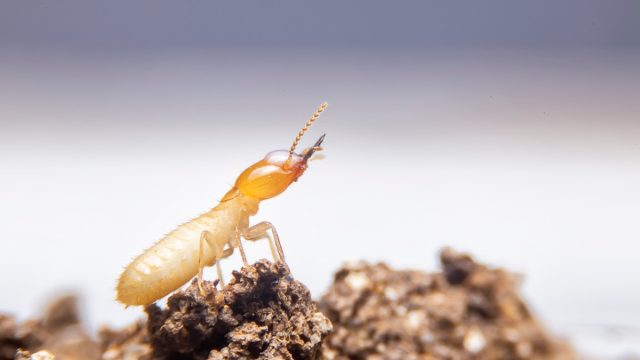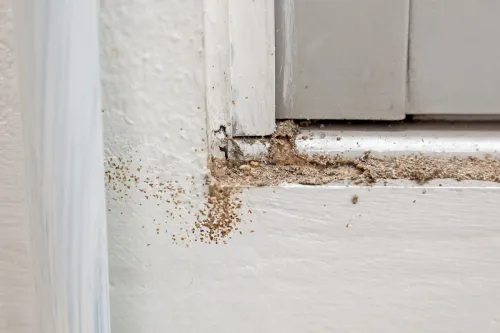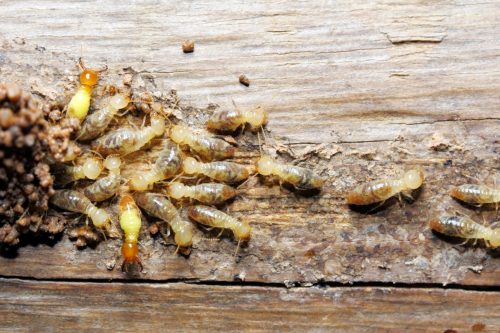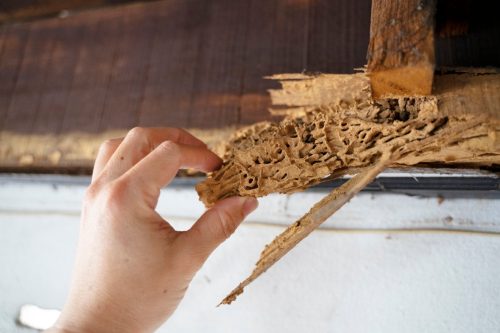The No. 1 Sign You Have Termites in Your Home, Experts Say

From spiders to roaches, there are many pests we would rather not take up residence in our home. But none of these insect and arachnid invaders can cause quite as much damage as a termite infestation can. Termites silently eat away at the foundation of your house, which could lead to thousands of dollars worth of damage or—in extreme cases—cause your house to collapse. And unlike spiders or roaches, it can be hard to spot termites, as they typically remain hidden within walls and floors. Thankfully, experts say there is one telltale sign of termites that you should be able to notice. Read on to find out the number one sign you have termites in your home.
RELATED: The No. 1 Sign There’s a Tarantula in Your Home, Experts Warn.
Mud tubes are the number one sign your home is infested with termites.

If you want to survey your home for termites, you should be on the lookout for mud tubes. These brownish tunnels are a “sure giveaway you have termites,” says Codey Stout, termite prevention specialist and head operations manager at Tree Triage.
“These mud tubes are used as access to their nest underground and help create their optimal climate by blocking out cool and dry air,” Burns Blackwell, the CEO of Terminix-Triad in Greensboro, North Carolina, explains. Jack Miller, a pest control expert and founder of How I Get Rid Of, says mud tubes look like a “trail of what appears to be chocolate dust.”
According to Blackwell, these tubes can be found in certain areas of your home. “If you notice pencil-sized mud tubes starting from the ground and climbing up the walls of your foundation, basement, or crawl space, this means that termites have chosen your home as their new stomping grounds,” he warns.
RELATED: This Is the No. 1 Sign There’s a Snake in Your House, Experts Say.
These mud tubes can cause other physical problems in your house.

Even if you don’t immediately see mud tubes, you may be able recognize their presence in other ways. Nicolas Holan, a pest expert and content manager for Goose Smurfs, says that frequent short circuits could be a sign that termites have built up mud tubes near you electrical work.
“If you’re always experiencing unusual short circuits, termites might be the reason behind it. Termites are often attracted to the warmth that the electrical fitting produces,” Holan explains. “When things like this occur, immediately check your wirings to verify if there are mud soil build-ups created by the termites.”
Ryan Smith, a pest control specialist and owner of Ant & Garden Organic Pest Control, says that stiff windows may also be a sign that termites are invading your home—especially if those windows are made of wood. “Termites love and require a moist nest. This high moisture environment that they create can deform wood, causing stiff and hard-to-open windows,” Smith explains. Paint peeling, dropping drywall, and buckling wood may also be signs of termites, Stout says.
Termite damage is not usually covered by insurance.

Scot Hodges, a certified entomologist and pest expert with Arrow Exterminators, says termites are “among the most devastating intruders a homeowner could ever face.” According to DC Scientific Pest Control, termites cost U.S. homeowners around $5 billion every year, with the average cost of repairs for each home’s worth of termite damage being $3,300.
“The startling fact is termites do more damage to homes than fires and storms combined, and yet the damage is rarely covered by homeowner’s insurance since termite damage is considered preventable through proper home maintenance and termite protection,” Hodges warns.
He adds that termites will likely have already caused significant damage to your home once you see them physically, so it’s important to be on the lookout for their telltale signs first.
RELATED: For more on the pests that could be invading your home, sign up for our daily newsletter.
You should call a pest expert if you think you have termites.

Michael Thome, an associate certified entomologist with Ehrlich Pest Control, says prevention is always the first step when it comes to termites, which includes removing stored wood and debris from around your home and repairing leaky taps and pipes that attract termites. But if prevention isn’t enough, it’s still important to fight this pest as soon as you can, as termites can invade your house within just one day.
“If you discover termites in your home, you should not attempt to get rid of them yourself,” Thome warns. “If termites are disturbed, they will simply re-route their activity to another area of the house. A termite specialist from a pest management company will be able to assess and apply proper treatment.”
RELATED: The No. 1 Sign You Have Black Widows in Your Home, Experts Warn.